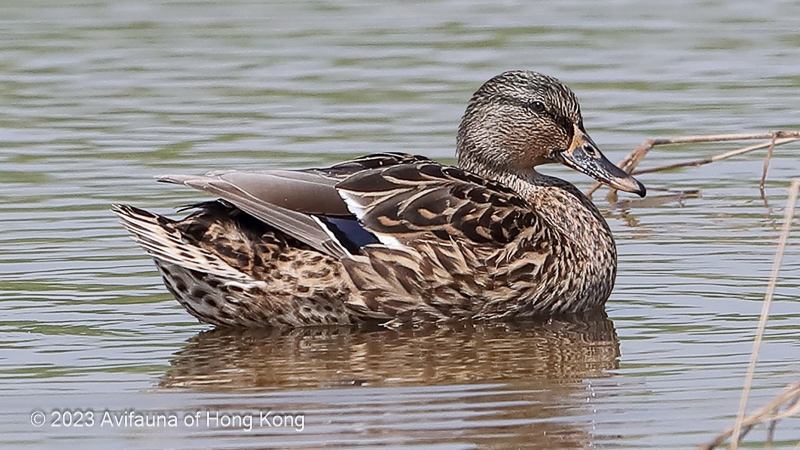Mallard Anas platyrhynchos 綠頭鴨
Category I. Rare winter visitor. Much declined this century.
IDENTIFICATION

Apr. 2017, Michelle and Peter Wong. Male.
50-60 cm. Large duck with orange legs, long bill and short tail; blue speculum bordered white and rounded wing tips in flight.
Adult male has dull yellow bill, green head with narrow white collar, dark brown chest, pearl grey belly, flanks and vent and black undertail coverts. Eclipse male retains bill and leg colour.

Nov. 2017, Michelle and Peter Wong. Female.
Adult female is brown with darker streaking and has orange bill with varying area of black on culmen and sides, dark eye stripe reaching base of bill and dark central crown; in flight underwing coverts white and belly buff.
VOCALISATIONS
The most often heard call is uttered by the female, a decrescendo ‘quack-quack-quack-qua-qua’, with the first two syllables louder than the subsequent notes.
The male gives a rather dry and throaty call.
DISTRIBUTION & HABITAT PREFERENCE
Most records are from Deep Bay, and almost all others have come from the New Territories, including Tai Lam Chung and Hok Tau Reservoirs, Kam Tin, Tolo Harbour, Nam Chung, Long Valley, Shuen Wan and Ho Chung. There have only been two records away from Deep Bay this century, however.
OCCURRENCE
Until the end of the 1990s Mallard was an uncommon winter visitor primarily from the third week of October to the first week of April, with extreme dates of 5 October 1959 and 30 April 1967. During this century, however, Mallard has been a scarce, probably now rare, winter visitor from the fourth week of October to the third week of April, with extreme dates of 17 October to 4 May and single records on 22 May and 7 August. Figure 1 illustrates the numbers recorded in waterbird counts since 1979.
The maximum count is 70 in Tolo Harbour on 7 November 1959, perhaps suggesting that it used to be more numerous than the 1990s, while in Deep Bay the highest count is 54 on 13 January 1996. However, the highest count this century is only 15 on 14 January 2001. It is possible that this decline in numbers, which has also happened to Eastern Spot-billed Duck, is associated with milder winters arising from climate change.
Vaughan and Jones (1913) described Mallard as an ‘unusual winter visitor to the West River’ and did not refer to any records from HK. La Touche (1931-34) stated that it was ‘an abundant winter’ visitor to Fujian and northeast Guangdong, though rarer or even uncommon at the coast below Shan Tou in eastern Guangdong. Macfarlane and Macdonald (1966) described it as an ‘occasional visitor’ from October to March in HK.
BEHAVIOUR, FORAGING & DIET
No observations.
RANGE & SYSTEMATICS
Holarctic distribution breeding from Greenland, Iceland and Europe through central Eurasia as far as Sea of Okhotsk, and in Alaska and much of Canada (excluding the northeast). European populations less migratory than those in east Asia and North America. Winters in Europe, east Africa, northern part of the Indian subcontinent and central and south China, as well as Kamchatka south through Japan (Drilling et al. 2020). Occurs throughout China apart from high plateau areas, breeding from Xinjiang and Tibet across north China to the northeast, and wintering in areas south of the Yellow River (Liu and Chen 2021).
The nominate taxon occurs in most of the range including HK. The only other subspecies recognised is confined to Greenland.
CONSERVATION STATUS
IUCN: Least Concern. Population trend increasing.
Figure 1.

Drilling, N., R. D. Titman, and F. McKinney (2020). Mallard (Anas platyrhynchos), version 1.0. In Birds of the World (S. M. Billerman, Editor). Cornell Lab of Ornithology, Ithaca, NY, USA. https://doi.org/10.2173/bow.mallar3.01
Liu, Y. and S. H. Chen (eds) (2021). The CNG Field Guide to the Birds of China (in Chinese). Hunan Science and Technology Publication House, Changsha.

